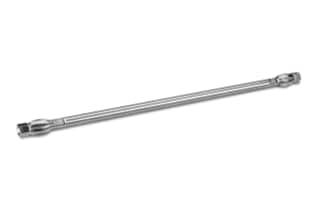
|
Chemistry |
C18 |
|
Separation Mode |
Reversed Phase |
|
Particle Substrate |
Hybrid |
|
pH Range Min |
1 pH |
|
pH Range Max |
12 pH |
|
Maximum Pressure |
6000 psi (415 Bar) |
|
Endcapped |
Yes |
|
Silanol Activity |
Low |
|
Molecular Weight Range Min |
1000 |
|
Molecular Weight Range Max |
15000 |
|
Particle Shape |
Spherical |
|
Particle Size |
3.5 µm |
|
Endfitting Type |
Waters |
|
Pore Size |
130 Å |
|
QC Tested |
Peptide |
|
Format |
Column |
|
Surface Area |
185 |
|
System |
HPLC |
|
Particle Technology |
BEH |
|
USP Classification |
L1 |
|
Inner Diameter |
4.6 mm |
|
Length |
250 mm |
|
Carbon Load |
17 % |
|
UNSPSC |
41115709 |
|
Application |
Peptide |
|
Brand |
XBridge |
|
Product Type |
Columns |
|
Units per Package |
1 pk |
XBridge Peptide BEH C18 Column, 130Å, 3.5 µm, 4.6 mm X 250 mm, 1K - 15K, 1/pk
Based on BEH Technology particles, XBridge Peptide BEH C18 Columns use Waters Peptide Separation Technology to deliver excellent separation of a wide variety of peptides. These columns are specially tested with a peptide map to ensure the stability of peptide separation methods, along with predictable behavior across the variety of samples that may be encountered in proteomics, protein characterization, and peptide synthesis. With narrow, symmetrical peaks for maximum resolution, these columns can be used to increase the resolution of complex peptide digests.
As a part of the XBridge family of columns, this column has been designed with a combination of cutting-edge bonding, end-capping, and particle synthesis, making it a trusted piece of lab equipment across the industry.
The superior peak shape and retention in formic acid and trifluoroacetic acid allow for optimal chromatography and seamless method migration from sub-2 µm UPLC technology to 10 µm preparative HPLC separations. By using the small-pore trifunctionally bonded BEH particle, XBridge Peptide BEH C18 Columns are able to offer the widest usable pH range, superior low pH stability, and ultra-low column bleed to assay samples for proteomics, protein characterization, and peptide synthesis.
All materials are manufactured in a cGMP-certified plant using ultra-pure reagents. Each batch of material has been qualified with a peptide separation, and results are held to narrow specification ranges that assure excellent and reproducible results across peptide separations. Each column is tested and a Performance Test Chromatogram and a Certification of Acceptance are provided. Further testing can be performed using Reversed-Phase QC Reference Material from Waters.
How Should I Use New XBridge Peptide BEH C18 Columns?
Before using a new column, you must confirm that it produces reproducible chromatography and the desired level of resolution. It is useful to benchmark column performance with a sample representative of intended application with your out-of-the-box column. Account for method variables such as pH, mass load, ionic strength, and ionic pairing, which could all have an impact on performance. The number of injections necessary to achieve reproducible performance may depend on sample characteristics and system type. Once this testing has been completed, you can begin regular use of columns.